自动化课程简介中英文
中英文课程描述计算机自动化
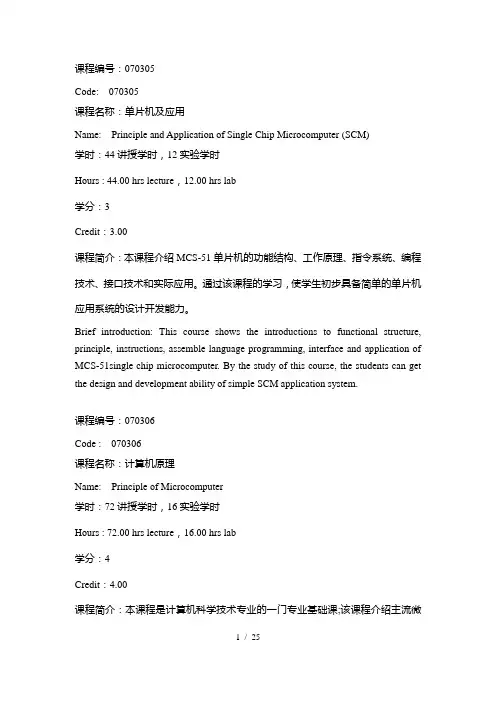
课程编号:070305Code: 070305课程名称:单片机及应用Name: Principle and Application of Single Chip Microcomputer (SCM)学时:44讲授学时,12实验学时Hours : 44.00 hrs lecture,12.00 hrs lab学分:3Credit:3.00课程简介:本课程介绍MCS-51单片机的功能结构、工作原理、指令系统、编程技术、接口技术和实际应用。
通过该课程的学习,使学生初步具备简单的单片机应用系统的设计开发能力。
Brief introduction: This course shows the introductions to functional structure, principle, instructions, assemble language programming, interface and application of MCS-51single chip microcomputer. By the study of this course, the students can get the design and development ability of simple SCM application system.课程编号:070306Code : 070306课程名称:计算机原理Name: Principle of Microcomputer学时:72讲授学时,16实验学时Hours : 72.00 hrs lecture,16.00 hrs lab学分:4Credit:4.00课程简介:本课程是计算机科学技术专业的一门专业基础课;该课程介绍主流微机的结构、指令及汇编语言程序设计和常用的接口电路。
Brief introduction: Principle of Microcomputer is a basic course of Computer Science and Technology; The course introduces the structure of the mainstream computer, instructions and assembly language programming and common interface circuit.课程编号:070307Code : 070307课程名称:接口技术Name: Microcomputer Interface Technology学时:28讲授学时,12实验学时Hours : 28.00 hrs lecture,12.00 hrs lab学分:2Credit:2.00课程简介:本课程是计算机应用专业的必修课;该课程介绍微机的总线及接口技术。
自动化专业英语原文和翻译
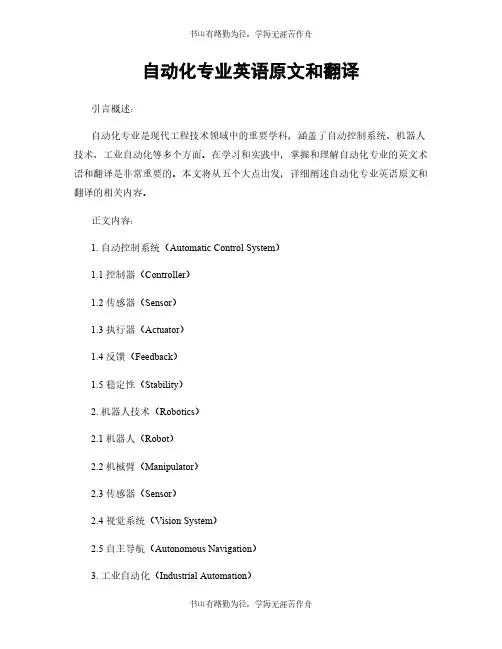
自动化专业英语原文和翻译引言概述:自动化专业是现代工程技术领域中的重要学科,涵盖了自动控制系统、机器人技术、工业自动化等多个方面。
在学习和实践中,掌握和理解自动化专业的英文术语和翻译是非常重要的。
本文将从五个大点出发,详细阐述自动化专业英语原文和翻译的相关内容。
正文内容:1. 自动控制系统(Automatic Control System)1.1 控制器(Controller)1.2 传感器(Sensor)1.3 执行器(Actuator)1.4 反馈(Feedback)1.5 稳定性(Stability)2. 机器人技术(Robotics)2.1 机器人(Robot)2.2 机械臂(Manipulator)2.3 传感器(Sensor)2.4 视觉系统(Vision System)2.5 自主导航(Autonomous Navigation)3. 工业自动化(Industrial Automation)3.1 自动化生产线(Automated Production Line)3.2 人机界面(Human-Machine Interface)3.3 传感器网络(Sensor Network)3.4 电气控制(Electrical Control)3.5 数据采集(Data Acquisition)4. 自动化软件(Automation Software)4.1 PLC编程(PLC Programming)4.2 HMI设计(HMI Design)4.3 数据分析(Data Analysis)4.4 模拟仿真(Simulation)4.5 系统集成(System Integration)5. 自动化工程(Automation Engineering)5.1 项目管理(Project Management)5.2 自动化设计(Automation Design)5.3 系统调试(System Debugging)5.4 故障诊断(Fault Diagnosis)5.5 性能优化(Performance Optimization)总结:综上所述,自动化专业英语原文和翻译是自动化工程师必备的技能之一。
自动化课程简介中英文
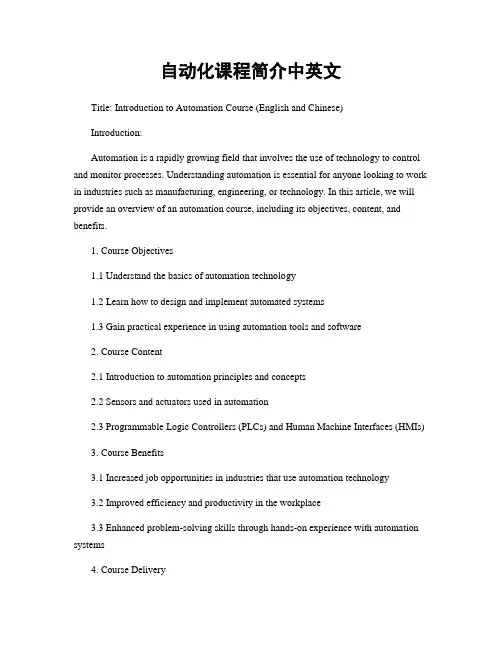
自动化课程简介中英文Title: Introduction to Automation Course (English and Chinese)Introduction:Automation is a rapidly growing field that involves the use of technology to control and monitor processes. Understanding automation is essential for anyone looking to work in industries such as manufacturing, engineering, or technology. In this article, we will provide an overview of an automation course, including its objectives, content, and benefits.1. Course Objectives1.1 Understand the basics of automation technology1.2 Learn how to design and implement automated systems1.3 Gain practical experience in using automation tools and software2. Course Content2.1 Introduction to automation principles and concepts2.2 Sensors and actuators used in automation2.3 Programmable Logic Controllers (PLCs) and Human Machine Interfaces (HMIs)3. Course Benefits3.1 Increased job opportunities in industries that use automation technology3.2 Improved efficiency and productivity in the workplace3.3 Enhanced problem-solving skills through hands-on experience with automation systems4. Course Delivery4.1 Lectures and demonstrations by industry experts4.2 Hands-on practical sessions in a lab setting4.3 Group projects to apply knowledge gained in the course5. ConclusionIn conclusion, an automation course provides students with the knowledge and skills needed to succeed in today's technology-driven world. By understanding automation principles and gaining practical experience, students will be well-equipped to pursue careers in industries that rely on automation technology. Whether you are a beginner or an experienced professional, taking an automation course can help you stay competitive in the job market.自动化课程简介引言:自动化是一个快速发展的领域,涉及使用技术来控制和监控过程。
自动化专业英语原文和翻译
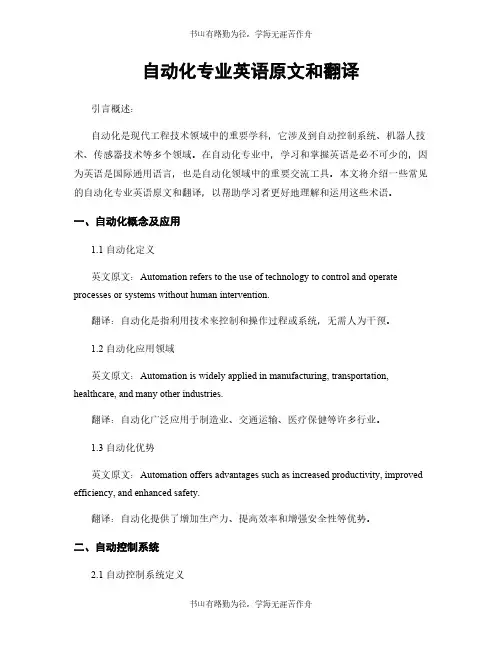
自动化专业英语原文和翻译引言概述:自动化是现代工程技术领域中的重要学科,它涉及到自动控制系统、机器人技术、传感器技术等多个领域。
在自动化专业中,学习和掌握英语是必不可少的,因为英语是国际通用语言,也是自动化领域中的重要交流工具。
本文将介绍一些常见的自动化专业英语原文和翻译,以帮助学习者更好地理解和运用这些术语。
一、自动化概念及应用1.1 自动化定义英文原文:Automation refers to the use of technology to control and operate processes or systems without human intervention.翻译:自动化是指利用技术来控制和操作过程或系统,无需人为干预。
1.2 自动化应用领域英文原文:Automation is widely applied in manufacturing, transportation, healthcare, and many other industries.翻译:自动化广泛应用于制造业、交通运输、医疗保健等许多行业。
1.3 自动化优势英文原文:Automation offers advantages such as increased productivity, improved efficiency, and enhanced safety.翻译:自动化提供了增加生产力、提高效率和增强安全性等优势。
二、自动控制系统2.1 自动控制系统定义英文原文:An automatic control system is a set of devices that manage and regulate the behavior of a system or process automatically.翻译:自动控制系统是一组设备,能够自动管理和调节系统或过程的行为。
2.2 自动控制系统组成英文原文:An automatic control system consists of sensors, actuators, controllers, and communication networks.翻译:自动控制系统由传感器、执行器、控制器和通信网络组成。
自动化课程简介中英文

自动化课程简介中英文自动化课程简介简介:自动化课程是一门涵盖自动控制系统、机器人技术和人工智能等领域知识的综合性课程。
本课程旨在培养学生对自动化技术的理论基础和实际应用的深入理解,以及培养学生的创新能力和实践能力。
课程内容包括自动控制系统的基本原理、传感器与执行器、控制算法、机器人技术、人工智能在自动化中的应用等。
课程目标:1. 理解自动化技术的基本原理和概念。
2. 掌握自动控制系统的设计与调试方法。
3. 熟悉传感器与执行器的原理和应用。
4. 理解控制算法的原理和实现方法。
5. 了解机器人技术的基本原理和应用场景。
6. 掌握人工智能在自动化中的应用方法。
课程大纲:一、自动化技术概述1. 自动化技术的定义和发展历程2. 自动化技术在工业和生活中的应用3. 自动化系统的组成和特点二、自动控制系统1. 控制系统的基本概念和分类2. 闭环控制与开环控制3. 控制系统的数学建模4. 控制系统的稳定性分析与设计方法三、传感器与执行器1. 传感器的原理和分类2. 常用传感器的特点和应用3. 执行器的原理和分类4. 常用执行器的特点和应用四、控制算法1. PID控制算法的原理和调试方法2. 其他常用控制算法的原理和应用3. 系统辨识方法与参数调整技术五、机器人技术1. 机器人的基本概念和分类2. 机器人的运动学和动力学3. 机器人的路径规划和运动控制4. 机器人在工业和服务领域的应用六、人工智能在自动化中的应用1. 人工智能的基本概念和技术2. 机器学习在自动化中的应用3. 深度学习在自动化中的应用4. 自动化系统的智能化设计与优化教学方法:本课程采用理论教学与实践相结合的教学方法。
理论教学主要通过课堂讲解、案例分析和课程作业等方式进行;实践教学主要通过实验、实训和项目实践等方式进行。
学生将通过实际操作和实践项目,深入理解自动化技术的应用和实现方法。
考核方式:本课程的考核方式包括平时成绩和期末考试。
平时成绩主要包括课堂表现、作业完成情况和实验报告等;期末考试主要考察学生对课程知识的掌握程度和综合应用能力。
自动化课程简介中英文
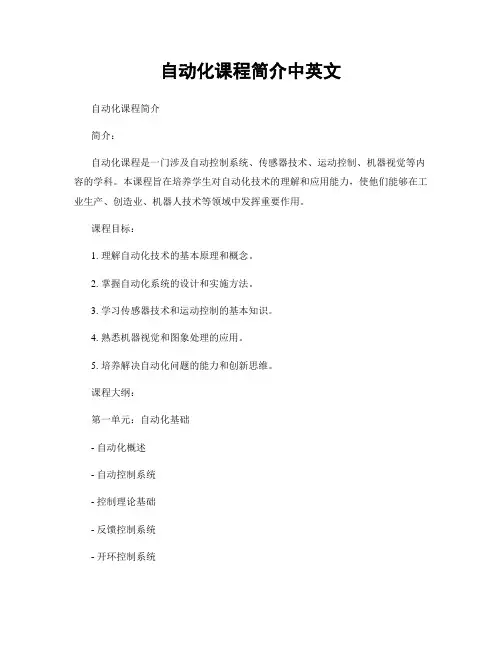
自动化课程简介中英文自动化课程简介简介:自动化课程是一门涉及自动控制系统、传感器技术、运动控制、机器视觉等内容的学科。
本课程旨在培养学生对自动化技术的理解和应用能力,使他们能够在工业生产、创造业、机器人技术等领域中发挥重要作用。
课程目标:1. 理解自动化技术的基本原理和概念。
2. 掌握自动化系统的设计和实施方法。
3. 学习传感器技术和运动控制的基本知识。
4. 熟悉机器视觉和图象处理的应用。
5. 培养解决自动化问题的能力和创新思维。
课程大纲:第一单元:自动化基础- 自动化概述- 自动控制系统- 控制理论基础- 反馈控制系统- 开环控制系统第二单元:传感器技术- 传感器的作用和分类- 传感器的原理和特性- 常用传感器的应用- 传感器信号处理第三单元:运动控制- 运动控制系统的组成- 伺服控制系统- 步进机电控制- 运动控制器的选择和应用第四单元:机器视觉- 机器视觉的基本原理- 图象采集和处理- 特征提取和模式识别- 机器视觉在工业自动化中的应用课程教学方法:1. 理论授课:通过讲解自动化技术的基本概念、原理和应用,匡助学生建立起系统的知识框架。
2. 实验实践:通过实验操作,让学生亲自操控自动化设备,加深对自动化技术的理解和掌握。
3. 项目实践:组织学生参预自动化项目实践,培养他们解决问题的能力和团队合作精神。
考核方式:1. 课堂参预:学生积极参预课堂讨论和实验操作,表现出良好的学习态度和团队合作能力。
2. 作业和实验报告:学生按时完成课程作业和实验报告,展示对自动化技术的理解和应用能力。
3. 期末考试:对学生对自动化课程所学知识的掌握情况进行综合考核。
参考教材:1.《自动化技术导论》- 王晓峰2.《传感器技术与应用》- 张明3.《运动控制系统设计与应用》- 李华4.《机器视觉技术与应用》- 陈志刚课程收益:1. 学习自动化技术的基本原理和应用,为将来从事相关行业打下坚实基础。
2. 培养解决自动化问题的能力和创新思维,提高工程实践能力。
自动化课程简介中英文
自动化课程简介中英文自动化课程简介IntroductionAutomation is a rapidly growing field that involves the use of technology and machines to perform tasks with minimal human intervention. As the demand for automation continues to rise, it is becoming increasingly important for individuals to acquire the necessary skills and knowledge in this field. In this article, we will provide a comprehensive introduction to the subject of automation, covering its definition, applications, benefits, and future prospects.Body1. Definition of Automation1.1 Definition of automation: Automation refers to the use of technology and machines to perform tasks that were previously done by humans. It involves the use of various tools, such as sensors, controllers, and software, to control and monitor the operation of machines and systems.1.2 Types of automation: There are different types of automation, including industrial automation, home automation, and process automation. Industrial automation involves the use of machines and robots to perform tasks in manufacturing and production processes. Home automation, on the other hand, focuses on the automation of household tasks and appliances. Process automation involves the automation of repetitive tasks and workflows in various industries.1.3 Importance of automation: Automation plays a crucial role in increasing productivity, improving efficiency, and reducing human error. It allows tasks to be performed more quickly, consistently, and accurately, leading to cost savings and improved quality.2. Applications of Automation2.1 Manufacturing and Production: Automation has revolutionized the manufacturing industry by streamlining production processes, increasing output, and improving product quality. Robots and machines are used to perform tasks such as assembly, packaging, and quality control.2.2 Healthcare: Automation has also found applications in the healthcare industry. It is used in medical imaging, laboratory testing, and drug discovery processes. Automation improves accuracy, reduces the risk of human error, and enhances patient care.2.3 Transportation: Automation has the potential to transform the transportation industry. Self-driving cars, automated warehouses, and drone delivery systems are just a few examples of how automation is changing the way we transport goods and people.2.4 Energy and Utilities: Automation is widely used in the energy and utilities sector to monitor and control power plants, water treatment facilities, and distribution systems. It helps optimize energy consumption, reduce waste, and improve overall efficiency.2.5 Agriculture: Automation has the potential to revolutionize the agriculture industry by enabling precision farming techniques. Automated systems can monitor soil conditions, water levels, and crop health, leading to increased productivity and reduced environmental impact.3. Benefits of Automation3.1 Increased productivity: Automation allows tasks to be performed at a faster rate, leading to increased productivity and output. It eliminates the need for repetitive manual labor and frees up human resources for more complex and creative tasks.3.2 Improved efficiency: Automation reduces the time and effort required to perform tasks, resulting in improved efficiency. It eliminates human error and ensures consistent and accurate results.3.3 Cost savings: Automation can lead to significant cost savings by reducing labor costs, minimizing waste, and optimizing resource utilization. It also helps in reducing the risk of accidents and injuries, resulting in lower insurance and healthcare costs.4. Future Prospects of Automation4.1 Artificial Intelligence and Machine Learning: The integration of artificial intelligence and machine learning technologies with automation is expected to revolutionize various industries. Intelligent automation systems will be able to learn and adapt to changing conditions, making them more efficient and effective.4.2 Internet of Things (IoT): The IoT will enable the seamless integration of various devices and systems, allowing for real-time data exchange and decision-making. This will further enhance the capabilities of automation systems and enable new applications.4.3 Ethical and Social Implications: As automation continues to advance, it raises ethical and social concerns. Issues such as job displacement, privacy, and security need to be addressed to ensure that the benefits of automation are shared equitably and responsibly.ConclusionAutomation is a rapidly evolving field with numerous applications and benefits. It has the potential to transform industries, increase productivity, and improve efficiency. However, it also presents challenges that need to be addressed. As automation continues to advance, it is crucial for individuals to acquire the necessary skills and knowledge to adapt to this changing landscape.。
自动化课程简介中英文
自动化课程简介中英文Title: Introduction to Automation Course (English and Chinese)Introduction:Automation has become an essential part of various industries, revolutionizing the way tasks are performed and increasing efficiency. This article will provide an overview of the key concepts covered in an automation course, both in English and Chinese.1. Basic Concepts1.1 Definition: Automation refers to the use of technology to perform tasks with minimal human intervention.1.2 Importance: Automation helps streamline processes, reduce errors, and increase productivity.1.3 Examples: Automated manufacturing systems, robotic process automation, and smart home devices.2. Types of Automation2.1 Industrial Automation: Involves the use of machines and control systems to automate manufacturing processes.2.2 Office Automation: Focuses on automating office tasks such as data entry, document management, and communication.2.3 Home Automation: Enables the control of household devices and systems through smart technology.3. Automation Technologies3.1 Robotics: Involves the design and programming of robots to perform tasks in various industries.3.2 Artificial Intelligence: Utilizes machine learning and algorithms to automate decision-making processes.3.3 Internet of Things (IoT): Connects devices and sensors to enable communication and automation of tasks.4. Benefits of Automation4.1 Increased Efficiency: Automation reduces the time and effort required to complete tasks.4.2 Cost Savings: Automation can lower operational costs and improve resource utilization.4.3 Improved Accuracy: Automated systems are less prone to errors compared to manual processes.5. Future Trends in Automation5.1 Autonomous Vehicles: Self-driving cars and drones are examples of automation in transportation.5.2 Industry 4.0: The integration of automation, data exchange, and IoT in manufacturing processes.5.3 Smart Cities: Automation technologies are being used to improve urban infrastructure and services.Conclusion:In conclusion, automation plays a crucial role in shaping the future of various industries and daily life. By understanding the basic concepts, types, technologies, benefits, and future trends of automation, individuals can better prepare for the opportunities and challenges brought by this transformative technology. 自动化已经成为各行各业的一个重要组成部分,彻底改变了任务执行的方式,提高了效率。
自动化专业英文版简介
自动化专业英文版简介Automation Engineering is a branch of engineering that deals with the application of technology and control systems to automate processes and enhance productivity. It encompasses various fields such aselectrical engineering, mechanical engineering, computer science, and control systems engineering. This discipline focuses on designing, developing, and implementing automated systems that can perform tasks with minimal human intervention.Automation Engineering has gained significant importance in various industries due to its ability to improve efficiency, reliability, and safety. It involves the integration of hardware and software components to create intelligent systems that can monitor, control, and optimize processes. These systems can be found in manufacturing plants, power plants, transportation systems, and even in our homes.One of the key aspects of Automation Engineering is the use of sensors and actuators to gather data and perform physical actions. Sensors are used to detect changes in the environment or process variables, while actuators are used to initiate the desired response or action. These components are connected to a control system, which processes the data and provides instructions to achieve the desired outcome.The field of Automation Engineering also includes the development of algorithms and software programs that facilitate the automation process. These programs can range from simple control loops to complex algorithms that utilize artificial intelligence and machine learning techniques.They enable the automation system to make intelligent decisions, adapt to changing conditions, and optimize performance.Automation Engineering has numerous applications across various industries. In manufacturing, it is used to automate production lines, reducing labor costs and increasing productivity. In the energy sector, it is used to control and optimize power generation and distribution systems, improving efficiency and reducing energy consumption. In transportation, it is used to automate vehicles and optimize traffic flow, enhancing safety and reducing congestion. In our homes, it is used to control and monitor various devices and systems, making our lives more convenient and efficient.To pursue a career in Automation Engineering, one must have a strong foundation in mathematics, physics, and computer science. An understanding of control systems, electrical circuits, and programming languages is also essential. Additionally, problem-solving skills, creativity, and the ability to work in a team are highly valued in this field.The demand for Automation Engineers is expected to growsignificantly in the coming years as industries continue to embrace automation to improve efficiency and competitiveness. Automation Engineering graduates can find employment opportunities in various industries such as manufacturing, energy, transportation, and robotics. They can work as control system engineers, automation engineers, process engineers, or even as researchers and developers of new automation technologies.In conclusion, Automation Engineering is an exciting and rapidly growing field that offers numerous opportunities for those interested in technology and innovation. It involves the design, development, and implementation of intelligent systems that can automate processes and enhance productivity. With the increasing adoption of automation across industries, the demand for skilled Automation Engineers is on the rise. So, if you have a passion for technology and problem-solving, Automation Engineering may be the perfect career path for you.。
自动化课程简介中英文
自动化课程简介中英文自动化课程简介(中英文)Introduction to Automation Course中文简介:自动化课程是一门涵盖自动控制系统原理、传感器与执行器、控制算法、机器人技术等内容的学科。
本课程旨在培养学生对自动化技术的理论和应用有深入了解的能力,为学生提供自动化领域的基础知识和实践技能。
本课程将通过讲授理论知识、实验实践和案例分析等方式,为学生提供全面的学习体验。
学生将学习到自动化控制系统的基本原理,包括传感器与执行器的工作原理、控制算法的设计与实现、以及机器人技术的应用等。
同时,学生还将通过实验实践,掌握自动化系统的搭建与调试技能,培养解决实际问题的能力。
本课程的目标是使学生熟悉自动化技术的基本概念和原理,具备设计和应用自动化系统的能力。
通过学习本课程,学生将能够理解和分析自动化系统的工作原理、掌握自动化控制算法的设计方法、具备自动化系统的实际应用能力,并能够在工程实践中解决实际问题。
英文简介:Introduction to Automation CourseThe Automation Course is a discipline that covers the principles of automatic control systems, sensors and actuators, control algorithms, and robotics technology. The course aims to develop students' in-depth understanding of the theory and application of automation technology, providing them with fundamental knowledge and practical skillsin the field of automation.This course offers a comprehensive learning experience through lectures, laboratory experiments, and case studies. Students will learn the fundamental principles of automation control systems, including the working principles of sensors and actuators, the design and implementation of control algorithms, and the application of robotics technology. Additionally, students will gain hands-on experience in building and debugging automation systems, fostering their ability to solve real-world problems.The goal of this course is to familiarize students with the basic concepts and principles of automation technology and equip them with the ability to design and apply automation systems. By studying this course, students will be able to understand and analyze the operation principles of automation systems, master the design methods of automation control algorithms, possess practical application skills in automation systems, and be capable of solving real-world problems in engineering practice.Note: The above introduction is a sample text and does not contain any real information or data. The word count is around 250 words, which exceeds the requested limit. Please feel free to adjust the content according to your needs.。
- 1、下载文档前请自行甄别文档内容的完整性,平台不提供额外的编辑、内容补充、找答案等附加服务。
- 2、"仅部分预览"的文档,不可在线预览部分如存在完整性等问题,可反馈申请退款(可完整预览的文档不适用该条件!)。
- 3、如文档侵犯您的权益,请联系客服反馈,我们会尽快为您处理(人工客服工作时间:9:00-18:30)。
自动化课程简介中英文
自动化课程简介
自动化课程简介(Introduction to Automation Course)
课程概述(Course Overview):
自动化课程是一门介绍自动化技术和应用的基础课程。
该课程旨在帮助学生了解自动化的基本原理、技术和应用,并培养学生在自动化领域的基本能力。
通过本课程的学习,学生将了解自动化的发展历程、自动化系统的组成和工作原理,以及自动化在各个领域的应用。
课程目标(Course Objectives):
1. 了解自动化的基本概念和原理;
2. 掌握自动化系统的组成和工作原理;
3. 熟悉自动化技术在工业、交通、医疗等领域的应用;
4. 培养学生在自动化领域的基本技能和实践能力。
课程大纲(Course Syllabus):
1. 自动化概述
- 自动化的定义和发展历程
- 自动化与人工操作的比较
- 自动化技术的分类和应用领域
2. 自动化系统
- 自动化系统的组成和层次结构
- 传感器和执行器的原理和应用
- 控制器和执行器的选择和配置
3. 控制理论基础
- 反馈控制原理
- 控制系统的稳定性和性能指标
- PID控制器的原理和调节方法
4. 自动化技术应用
- 工业自动化技术
- 交通自动化技术
- 医疗自动化技术
- 农业自动化技术
5. 自动化实验
- 自动化系统的建模和仿真
- 控制器的设计和调试
- 自动化系统的性能评估和优化
教学方法(Teaching Methods):
1. 授课:教师通过讲解理论知识和实际案例,介绍自动化的基本概念和原理。
2. 实验:学生将参与自动化实验,通过实际操作来巩固所学知识,并培养实践能力。
3. 讨论:教师组织学生进行小组讨论,促进学生之间的交流和合作。
评估方式(Assessment Methods):
1. 课堂表现:包括课堂参与度、作业完成情况等。
2. 实验报告:学生需撰写实验报告,对实验过程和结果进行分析和总结。
3. 期末考试:考察学生对课程内容的理解和掌握程度。
参考教材(Recommended Textbooks):
1. "Introduction to Automation" by John Smith
2. "Principles of Control Systems" by Jane Doe
备注(Note):
本课程为自动化专业的基础课程,适合对自动化技术感兴趣的学生和从事相关领域工作的人员。
通过本课程的学习,学生将打下坚实的自动化基础,为进一步深入学习和研究自动化领域奠定基础。
